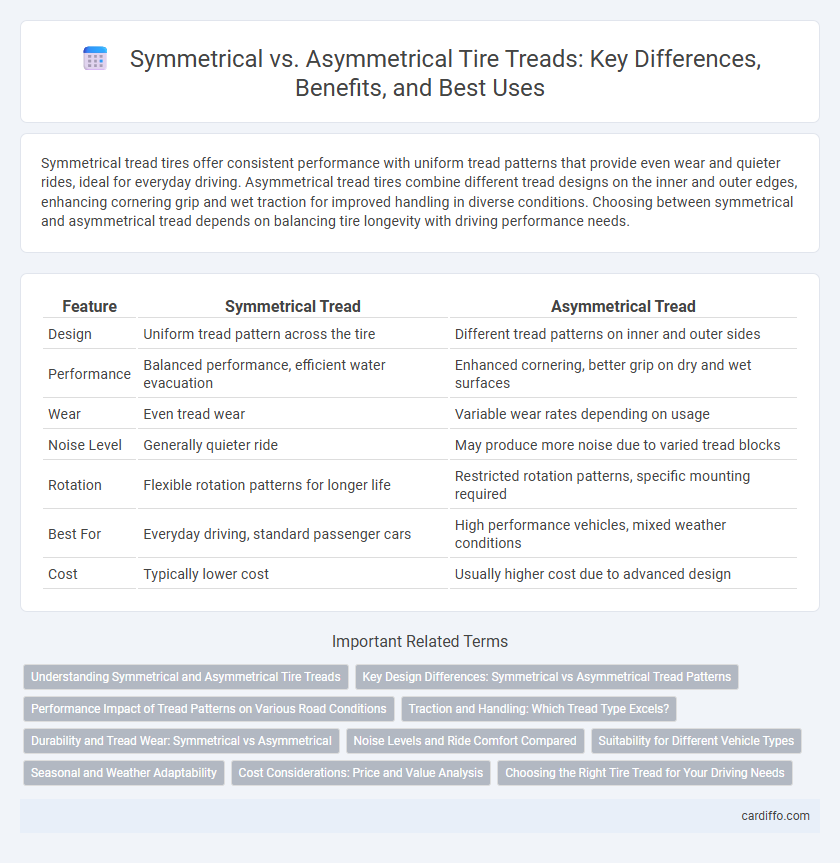Symmetrical tread tires offer consistent performance with uniform tread patterns that provide even wear and quieter rides, ideal for everyday driving. Asymmetrical tread tires combine different tread designs on the inner and outer edges, enhancing cornering grip and wet traction for improved handling in diverse conditions. Choosing between symmetrical and asymmetrical tread depends on balancing tire longevity with driving performance needs.
Table of Comparison
| Feature | Symmetrical Tread | Asymmetrical Tread |
|---|---|---|
| Design | Uniform tread pattern across the tire | Different tread patterns on inner and outer sides |
| Performance | Balanced performance, efficient water evacuation | Enhanced cornering, better grip on dry and wet surfaces |
| Wear | Even tread wear | Variable wear rates depending on usage |
| Noise Level | Generally quieter ride | May produce more noise due to varied tread blocks |
| Rotation | Flexible rotation patterns for longer life | Restricted rotation patterns, specific mounting required |
| Best For | Everyday driving, standard passenger cars | High performance vehicles, mixed weather conditions |
| Cost | Typically lower cost | Usually higher cost due to advanced design |
Understanding Symmetrical and Asymmetrical Tire Treads
Symmetrical tire treads feature continuous and consistent patterns across the entire tire, providing uniform contact with the road that enhances stability and longevity. Asymmetrical tire treads combine different patterns on the inner and outer sections, optimizing both wet traction and cornering performance while improving overall handling. Understanding the differences helps drivers select tires tailored to their specific driving conditions and performance preferences.
Key Design Differences: Symmetrical vs Asymmetrical Tread Patterns
Symmetrical tread patterns feature continuous ribs or independent tread blocks across the entire tire, promoting even wear and a quiet ride ideal for regular driving conditions. Asymmetrical tread designs combine different tread patterns on the inner and outer sections of the tire, optimizing traction, cornering performance, and water evacuation. The distinct inner tread typically enhances wet grip, while the outer tread focuses on handling stability and dry surface performance.
Performance Impact of Tread Patterns on Various Road Conditions
Symmetrical tread tires provide consistent performance and even wear on dry and wet roads, offering stability and a quieter ride suited for everyday driving. Asymmetrical tread designs enhance grip and cornering by combining different tread patterns in one tire, optimizing traction on dry surfaces while efficiently dispersing water on wet roads. The choice between these treads significantly impacts driving dynamics, with asymmetrical treads delivering superior performance in variable road conditions and high-speed scenarios.
Traction and Handling: Which Tread Type Excels?
Symmetrical tread patterns offer consistent traction and long tread life, making them ideal for everyday driving on dry and wet roads. Asymmetrical treads provide enhanced handling and cornering stability by combining different tread designs on the inner and outer tire edges, optimizing grip in various driving conditions. When prioritizing traction and responsive handling, asymmetrical tread tires generally outperform symmetrical ones, especially in high-performance and wet-weather scenarios.
Durability and Tread Wear: Symmetrical vs Asymmetrical
Symmetrical tread tires typically offer uniform tread wear, enhancing overall durability by evenly distributing stress across the tire's surface. In contrast, asymmetrical tread tires feature varied tread patterns that optimize grip and handling but may experience uneven wear, especially if not rotated regularly. Proper maintenance, including consistent tire rotation, is essential for maximizing the lifespan and performance of asymmetrical tread tires compared to symmetrical ones.
Noise Levels and Ride Comfort Compared
Symmetrical tread tires generate less road noise due to uniform tread patterns that maintain consistent contact with the road, enhancing ride comfort through reduced vibrations. Asymmetrical tread tires, designed with distinct inner and outer tread patterns, often produce higher noise levels but provide better handling and traction, sometimes compromising overall ride smoothness. Choosing between the two depends on prioritizing quieter, smoother rides with symmetrical treads or improved grip and performance with asymmetrical treads.
Suitability for Different Vehicle Types
Symmetrical tread tires suit compact cars and sedans by offering even wear and smooth handling at lower speeds. Asymmetrical tread tires are ideal for performance vehicles and SUVs, providing enhanced grip, especially during high-speed cornering and varied road conditions. Choosing the right tread pattern optimizes traction and safety based on the vehicle's design and driving demands.
Seasonal and Weather Adaptability
Symmetrical tread patterns excel in providing consistent performance and even wear, making them suitable for seasonal use in moderate weather conditions. Asymmetrical tread designs enhance grip and handling by combining different tread elements, optimizing traction on wet, dry, and varying road surfaces, especially during transitional seasons. This adaptability makes asymmetrical treads more effective for drivers facing mixed weather conditions throughout the year.
Cost Considerations: Price and Value Analysis
Symmetrical tread tires generally offer a more affordable price point due to simpler design and manufacturing processes, making them cost-effective for everyday driving needs. Asymmetrical tread tires, while often more expensive, provide enhanced performance benefits such as improved handling and traction, delivering greater value for performance-focused drivers. Evaluating cost against benefits ensures optimal investment, with symmetrical treads suited for budget-conscious users and asymmetrical treads for those prioritizing driving dynamics.
Choosing the Right Tire Tread for Your Driving Needs
Symmetrical tread patterns offer consistent performance and even wear, making them ideal for everyday driving and standard road conditions, while asymmetrical tread designs provide enhanced traction and handling by combining varied tread blocks tailored for wet and dry surfaces. Choosing the right tire tread depends on driving habits, vehicle type, and prevailing road conditions, with symmetrical treads suiting fuel efficiency and quieter rides, and asymmetrical treads excelling in cornering stability and grip. Prioritize tire tread features aligned with climate and speed requirements to optimize safety and tire longevity.
Symmetrical tread vs Asymmetrical tread Infographic

 cardiffo.com
cardiffo.com